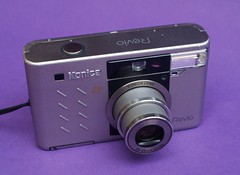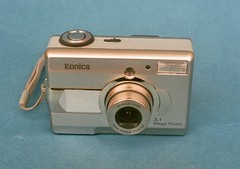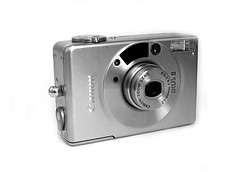APS film
The Advanced Photo System (or APS) was introduced in 1996 as an alternative to or even as modern replacement for the still-popular 35mm format.[1] The "IX240" film cartridges are optimized for fully automatic film load, enclosing the 24mm wide film completely when not in use. The film is even put back into its cartridge and returned to the user after it has been developed. Kodak stopped manufacturing APS film in 2011, Fujifilm also stopped manufacturing APS film in July, 2011 and stock had depleted by 2012.[2]
Most cameras support 3 exposure formats:
- C for "classic" (25.1 x 16.7 mm; aspect ratio 3:2; 4x6" print or 10x15 cm print)
- H for "HDTV" (30.2 x 16.7 mm; aspect ratio 16:9; 4x7" print or 10x18 cm print)
- P for "panoramic" (30.2 x 9.5 mm; aspect ratio 3:1; 4x12" print or 10x24 cm print)
The C and P formats are formed by cropping, each format can be selected via the camera (with the exception of some disposable cameras) at any time for use with the format. The H format is the original format. Every single image on the developed film has this format, the print format is just information written by the camera onto magnetic storage on the film - which is used by the printing equipment to crop the picture appropriately.
The approach of modern digital single lens reflex camera bodies in the heydays of APS film made it common to use the terms APS format or APS size for the size of DSLR image sensors. This was because they were smaller than 35mm film's 24×36mm format. But there were different size variants prefered by different camera makers:
- APS-H: 28.7×19 mm (Canon)
- APS-C: 23.6×15.7 mm (Sony, Nikon, Pentax, the three cooperate in sensor field)
- APS-C: 22.2×14.8 mm (Canon)
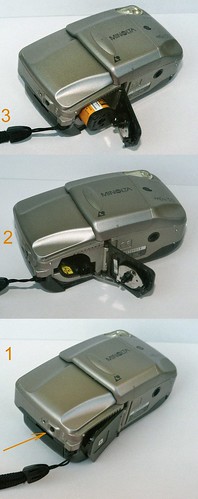
|
| loading a Minolta Vectis 30 1. press button 2. open film chamber door 3. put in film capsule and close door image by Uwe Kulick (Image rights) |
The magnetic data storage on the APS film is made possible by a transparent magnetic coating of the film's back. Data for certain purposes is stored there on several tracks. This offers a unique set of advantages:
- PQI print quality improvement by storage of film type, film length, film speed, film ID,
- and for each image the print format, the preselected number of prints, the title, and the exposure data.
Some APS-film-viewers offer the possibility of changing the information on this magnetic storage, for example to switch the print format, or to add information for a slideshow on that viewing device.
The exposure data is useful for corrections of underexposure or matters like that by the photo laboratory. It's also used for removing a film from a camera for putting it back into it later. Thus a photographer can switch from the color film he actually uses to a black and white film for some exposures, and vice versa, until both films are full. The additional mechanical marker in the film cartridge shows when a film is full. This marker shows whether the film is empty, in use, full, or developed.
The exposure numbers are stored twice, once as magnetic data, and another time enlighted on the film which has just one perforation with two holes per image. The film's basic material is refined polyethylene naphthalate (A-PEN) foil, and its film emulsion is improved compared to pre-1996 35mm film emulsions.
Contents
Examples of APS cameras
| cameras made by film makers | cameras made by other camera makers | single-use cams | |||||
 Fujifilm nexia Q1[3] |
 Kodak Advantix T550[4] |
 Konica Revio II[5] |
 Agfa Futura Af zoom[6] |
 Nikon Nuvis S 2000[7] |
 Canon IXUS[8] |
 Minolta Vectis GX-2[9] |
 Kodak Advantix Snap Kids[10] |
Adoption
Despite the features, its size hindered its adoption by professional photographers, having only 56% of the frame size of 35mm film at best in HDTV format; panorama format has only 30%. It was planned to give this sort of film a higher resolution to give APS users a clear advantage. But soon, 35mm films were sold with the same resolution. Most cameras for APS film were very compact, but some 35mm cameras were nearly as compact (for example some of the the Olympus µ or Rollei prego cameras) so even this advantage of APS was nearly neutralized. So the system was accepted mainly by those who liked the three print formats. Nevertheless the cute cameras had a lot of fans. Each of the big three camera makers produced a unique camera series for the APS films, the Nikon Nuvis, Canon (IXUS, ELPH, IXY) and Minolta Vectis series. Fujifilm offered two series of APS cameras, the Fotonex and the nexia cameras. Olympus made the i-zoom and the newpic series. APS users could even choose between several SLR camera bodies from Canon's IX, Nikon's Pronea series which also had new IX AF-lenses, and Minolta even created a new lens mount.
APS film was much better suited for use in compact 'point and shoot' cameras for the general public than for professional use. While it fulfilled this need well, less than 5 years after its release digital technology became affordable and convenient - pushing APS format into a very small market share, where it remains to this day. Though the film is still sold and developed in most places 35mm is, it can cost up to one and a half times as much to develop. Nowadays only film speeds 100, 200 and 400 ASA are available.
Since summer 2011 APS film production of Kodak and Fujifilm is ceased or at least reduced to a remaining Fuji product[11].
But the decline was just faster than that of 35mm film. The latter will survive, but on a low level of production. Thus 90 years after its market introduction 35mm film is a winner of still photography history, but probably a pyrrhic winner.
Predecessors of digital compacts
The digital cameras which offer features like compactness and 3 print formats are still expensive, like the Leica D-Lux 2, or have no viewfinder, like the Panasonic Lumix DMC LS3. So the APS system will stay popular for a while among its fans. But the characteristic conception of fully automatic compacts with zoom lens and optical zoom finder has already been taken over as one of the most popular digital camera layouts of today. But most of the recent digital compact camera models have no more viewfinder since their big bright LCD screens leave no space on camera backs for an ocular and replace the finder, and camera makers try to save costs by omitting the viewfinder. Thus the early digital compacts with viewfinder are already a classic type of camera, derived from the APS compacts.
|
| ||||
|
Film cartridges
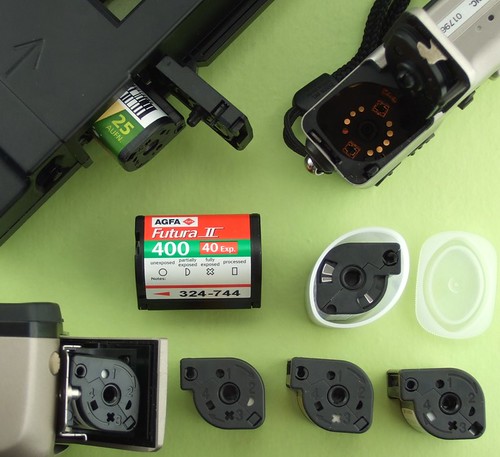
|
| Top: APS adaptor for film scanner, film slot of compact camera Middle: an APS film cartridge, another in sales capsule Bottom: four films in different states, the left one in the film slot of a SLR image by Uwe Kulick (Image rights) |
The film cartridges of the APS system differ from that of any other cartridged film rolls. That's because APS films are loaded fully automatically after closing a film load slot that's filled with a cartridge. On top of a cartridge a white symbol appears beside one of the numbers 1 to 4.
APS film states: symbol beside number
- full moon near 1: film is empty
- half moon near 2: film is not full
- the cross near 3: film is full
- rectangle near 4: film is developed
Better cameras like most APS SLRs allow unloading and reloading. That's interesting for those who want to switch between a 100 ASA film and a 400 ASA film as often as necessary until both films are full.

|
| left: opened APS film cartridge, right: 35mm film cartridge image by EspressoBuzz (Image rights) |
See also: Category:APS for more APS cameras.
Notes
- ↑ Advanced Photo System introduced; report by Ben Dobbin of APN, in the Kentucky New Era, 1 February 1996, archived at Google News Archive.
- ↑ Fujifilm To Discontinue APS Film (archived) on Popular Photography
- ↑ Image by Steve Harwood, license: Creative Commons (not for commercial use).
- ↑ Image by Mech for i, license: Creative Commons (not for commercial use).
- ↑ Image by Uwe Kulick, license: image used with permission, all rights reserved.
- ↑ Image by Uwe Kulick, license: image used with permission, all rights reserved.
- ↑ Image by Uwe Kulick, license: image used with permission, all rights reserved.
- ↑ Image by AWCam, license: image used with permission, all rights reserved.
- ↑ Image by Steve Harwood, license: Creative Commons (not for commercial use).
- ↑ Image by James Mincey, license: image used with permission, all rights reserved.
- ↑ In autumn 2011 Fujifilm USA website still showed Nexia ISO 400 APS film (archived).
Links
- Kodak redbook: APS (archived) at Kodak
- Flickr photo group of APS amateurs and professionals at Flickr
- submin.com's APS pages at Sub Mininiture Cameras
- how to open an APS cartridge at Camera Hacker
- another juxtaposition of APS-cams and digicams
In German
Literature
- Michael Simon, "Neue Wege der Fotografie mit Fujifilm", Gilching 1996, ISBN 3-88955-090-8 (German language)
- Heiner Henniges, "Die Neue Dimension der Fotografie", Augsburg 1996, ISBN 3-8043-5082-8 (German language)
